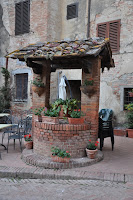On our final day we drove to Pisa for a quick visit before heading back to Florence to catch the train home. The drive was largely uneventful, except for the crazy Italian drivers who thought they were in a Formula One race.
Once in Pisa we found a parking spot along the river Arno. It wasn’t clear how long we could park there or whether we needed to pay, so I asked Emilie if we needed to worry about getting a ticket or getting towed. She responded that “it’s Italy and it’s Sunday.” Enough said, I guess.
As we didn’t have very much time to visit the city, we headed straight to the Piazza del Duomo to see the Torre Pendente (Leaning Tower) and its adjacent sites – the Duomo (cathedral) and Baptistery.
We unfortunately weren’t able to take the tour to the top of the tower, but the view from the ground was impressive in itself.
I was most impressed by the Duomo (a.k.a. Santa Maria Assunta), which dates back to the 11th century. Both the exterior and interior were very nice, with far less “austerity” than the Duomo in Florence
The adjacent Baptistery dates to the mid-12th century and is the largest baptistery in Italy
From the top floor there is a very nice view of the Duomo and (part of) the leaning tower.
For the balance of our time in Pisa
































































